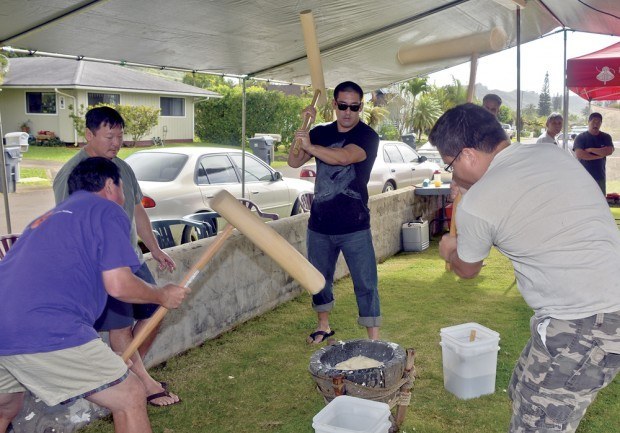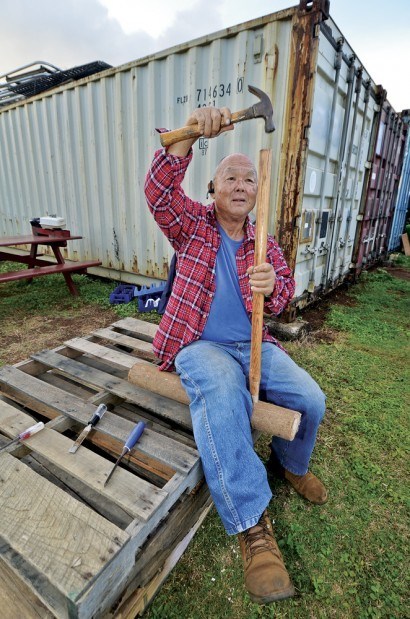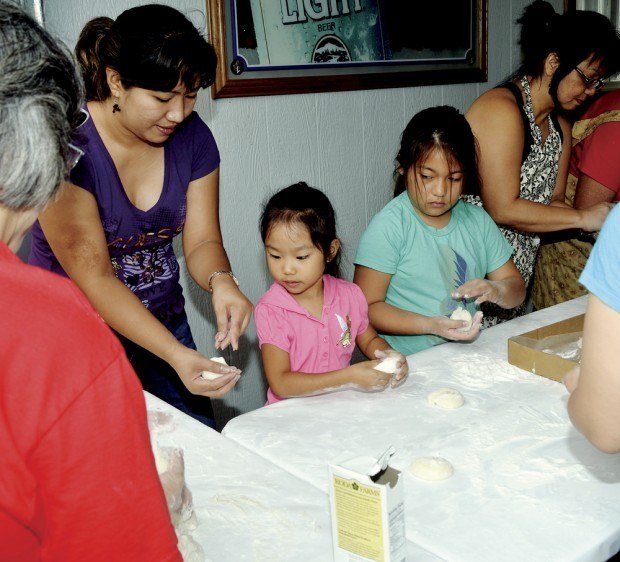WAILUA — Robert Kawamura, a junior at Kaua‘i High School, said he’s been pounding mochi for a long time, Monday in Wailua. Robert is the fourth generation of the Kawamura family and one of the younger members to wield the
WAILUA — Robert Kawamura, a junior at Kaua‘i High School, said he’s been pounding mochi for a long time, Monday in Wailua.
Robert is the fourth generation of the Kawamura family and one of the younger members to wield the specially made mallets used to turn mochi rice into a delicacy which is laced with symbolism for New Year’s Day.
“This is one of the best parts of making mochi, called mochitsuki in Japanese,” said Ed Kawamura, the second generation of the Kawamura ‘ohana who congregated at one of the family’s homes in Wailua for the annual event.
“Mochi is sticky rice and pulls everyone together,” Ed Kawamura said. “The head says ‘Come!’ and everyone comes to one place. It doesn’t matter what their opinions are. Everything comes together when you make mochi.”
Mochitsuki is one of the traditions of Japan which arrived with the first Japanese immigrants to Hawai‘i more than a century ago. After being shaped by other ethnic traditions, making mochi continues to be a tradition in different regions of the state.
“It’s for oshogatsu, or New Year’s,” said Bea Kawamura, the matriarch of the family who greeted all who arrived and watched the goings-on from the driveway, which was tented for the occasion. “It’s for good health and good fortune.”
The celebration of the Japanese New Year involves many customs and rituals that hold special symbolic meanings, according to the Japanese Cultural Center of Hawai‘i website.
The New Year itself represents a time to conclude activities of the passing year and a time to start fresh with parties to attend. A bonen kai is an end of the year celebration, and shinnen kai means New Year’s celebration. Each tradition symbolizes putting the past behind and starting with a new outlook for the coming year.
Mochi, or pounded rice cake, is always part of the Japanese New Year’s celebration, being a time when entire families gather to prepare, shape and fill the mochi.
Traditional mochitsuki involves the steaming of mochi rice. The rice is then pounded in an usu, or deep bowl, which is usually made usually of stone. The rice is pounded with a kine, or wooden mallet, until it reaches a consistency ready to be cut into the final mochi, or “round rice,” the website states.
“E rai ke, I told the boys I would buy a machine, but they don’t like that. They insist on doing it this way,” Bea said. “Once the rice is pounded, the ladies have to work just as hard.”
Bea said the process from usu to mochi involves special cutters who pass on the mochi to finishers, the final touch being the placing of azuki or plain bean paste, and the creation of the kagami mochi, or special New Year decoration.
“Not everybody can cut,” Bea said. “For all the people here, we only have two cutters — Karen and Susan — and if anything happens to them, no more mochi.”
She said the best time to eat the mochi is when it’s still warm, especially if it contains azuki bean paste.
“You can eat the kinako, or powdered ground dried soy bean, mochi, anytime, but the azuki mochi is best eaten on the day it is made,” she said.
The process for making mochi takes several days, Alan Okuhara of Mark’s Place and Contemporary Flavors Catering said. He usually soaks the rice four days to get the right consistency of mochi.
Alan Yamamoto tried to demonstrate the different consistencies by grinding out grains between his fingers to demonstrate the proper degree of soaking.
People gathered at M. Kawamura Farm Enterprises Friday evening to begin the process of creating the kine, or wooden mallets, used to pound the mochi.
Ed Kawamura was pleased that three generations of his family showed up, including young Robert, as well as some first-time mochi makers.
“I pounded my first mochi when I was 6 years old,” Robert said. “We usually have a kids’ batch, the final tray of the day, when the kids can try their hand at pounding.”
The mochi, besides being enjoyed fresh off the table, is part of the foods special to the Japanese New Year’s celebration called osechi ryori for good fortune, long life, good health and success.
One of these foods is the ozoni soup in which mochi is the key ingredient. The special soup symbolizes strength and prosperity.
The kagami mochi is rooted in Shintoism and the story of Amaterasuomikami, or the Sun Goddess, who hid in a cave and made the world dark, the JCCH website states.
According to the legend, people prayed to a mirror, symbolic of the goddess, for her return. When she reappeared, there would be great joy that brightened the skies.
The kagami mochi is made with a small mochi stacked on top of a larger one, which is placed on a clean sheet of white paper and topped with a tangerine symbolizing “generation to generation” and the continued reappearance of the Sun Goddess.
Hawai‘i custom calls for the kagami mochi to be displayed before New Year’s Eve and taken down and eaten after the New Year.
“The best part of making mochi is how it brings everybody together,” Leesha Kawamura said.
• Dennis Fujimoto can be reached at 245-3681 (ext. 253) or dfujimoto@ thegardenisland.com.





